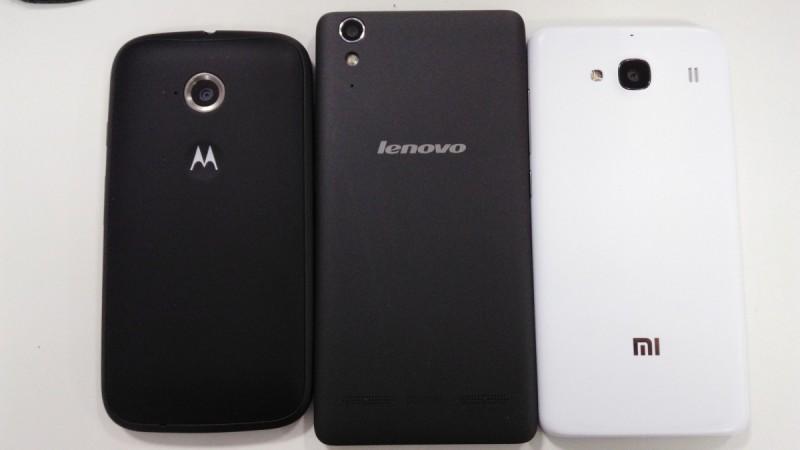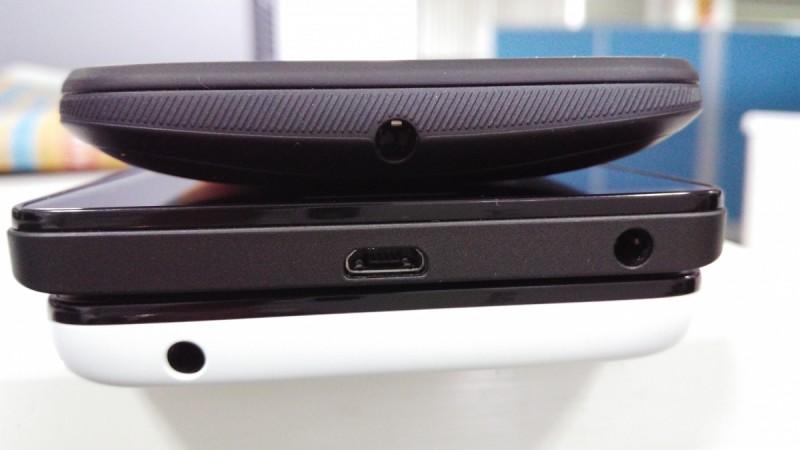
2015 is proving to be a great year for budget smartphone enthusiasts, who are spoilt for choice while opting for a smartphone. However, three of the best to talk about are Motorola's Moto E 2nd Generation or Moto E2, Xiaomi's Redmi 2 and Lenovo's A6000.
Featuring decent internal components and custom software, all three are impressive smartphones and cater to affordable smartphone market. Interestingly, all three of them are available for the same price. However, choosing which one is right for you can be tricky.
Note:- Motorola has released its latest budget smartphone Moto E 2nd Generation or Moto E2 in two variants. Both the smartphones feature similar display, battery, RAM and Internal Storage but differs in connectivity (3G vs 4G-LTE) and System-on-Chip (Qualcomm Snapdragon 200 vs Qualcomm Snapdragon ). Since Motorola has released the 3G only variant in India in the same price bracket other two phones are offered, we are considering the 3G only edition in this review.

Design
Though Moto E2, Redmi 2 and A6000 have used plastic for exterior casing. visually they are as different as they can get. The Moto E2 features a non-removable rubberised chassis with rounded side and corners.
The Redmi 2 and A6000 both use matte plastic, which doesn't look as solid as Moto E2's back panel.
Weighing 145g, the Moto E2 is 17g heavier than the Lenovo A6000 and 12g heavier than the Redmi 2.
Picking between the 129.9x66.8x12.3mm measurement of Moto E2, 134x67.2x9.4mm of Redmi 2 and 141x70x8.2mm of A6000, we found all three devices are comfortable to hold. But the curved back and rubberised exterior of Moto E2 is much ergonomic than the other two. But if you want your devices to be slim Lenovo A6000 should be your choice. Redmi 2 looks identical to its phablets sibling Redmi Note and features an average build quality. The similar look for all the devices might also be considered as a big letdown in this segment.
That said, the Moto E 2nd Generation is a clear winner in terms of build quality. With a water resistant coating the Moto E 2nd generation feels quite rugged in hand.
Winner- Moto E 2nd Generation

Display
Display specification is treated as the most prime feature in a smartphone and Motorola, Xiaomi and Lenovo have featured decent displays
The Moto E2 features a 540x960 pixels resolution, 244.8 PPI which works well in real life consumption but considering the latest trend the 540P (called as qHD or Quarter HD) it feels a bit dated.
Redmi 2 and A6000 both feature a 720P display but differ in size and PPI count. While the Redmi 2 houses a 4.7-inch display, A6000 boasts slightly bigger 5-inch display. In PPI count, Redmi 2 scores slightly higher with its 312.5PPI in contrast to A6000's 293.7PPI.
In terms of quality it's tough to judge the winner between the Redmi 2 and A6000. Both the phones offer decent brightness, ample sharpness and decent viewing angles. But in real life use we found the Redmi 2's display little better for its more balanced colour output. All three read well under the direct sunlight but the Lenovo A6000 lacks the necessary Corning Gorilla Glass protection.
Winner:- Xiaomi Redmi 2

Performance
The comparison is more interesting as all the 3 smartphones are available for similar prices. On paper, the Redmi 2 and A6000 both offer power house in its price. Featuring the identical 1.2GHz Quad-Core Snapdragon 410 SoC, both the phones offer 1GB RAM and 8GB inbuilt storage with memory expandability. It would be interesting if Motorola brought the 4G edition to the country, which features similar processor, RAM and storage space. But the currently available Moto E 2nd Generation offers a less powerful Snapdragon 200 SoC with similar amount of RAM and storage.
We used AnTuTu, Geekbench, Quadrant Standard and Vellamo Benchmark tools to test all three. All four benchmarks are good enough to test the performance of the devices and bring out the true picture.

The Moto E 2nd generation scored 17748 in AnTuTu Benchmark 5.6.2, 10016 in Quadrant Standard, 329 and 1131 in GeekBench single0core and multi-core test. In Vellamo Metal, Multicore and Browser benchmark it managed to achieve 771, 1360 and 1555 respectively.
The Xiaomi Redmi 2 had 20376 in AnTuTu, 11806 in Quadrant Standard, 472 and 1392 in GeekBench Single Core and Multi Core. While in Vellamo Metal, MultiCore and Browser it scored 866, 1247 and 2061 respectively.
We found the Lenovo A6000 performance quite similar to Redmi 2's scores on most of the benchmarks but scored higher in AnTuTu and GeekBench test. It scored 20807 in AnTuTu, 11723 in Quadrant, 491 in GeekBench Single-Core, 1482 in GeekBench Multi Core, 813 in Vellamo Metal, 1200 in Vellaomo MultiCore and 2043 in Vellamo Browser test.
We found the statistics came true with real world performance and the Lenovo A6000 did little better than the other two in the competition.
Between the Moto E 2nd generation, Xiaomi Redmi 2 and Lenovo A6000 we found the Lenovo's handset has a slight edge.
Winner:- Lenovo A6000
Software
In this segment Moto E 2nd Generation stands as clear winner over the other two smartphones. In comparison with Redmi 2 and A6000's Android Kitkat 4.4.4, the Moto E 2nd Generation runs on Android 5.0.2 Lollipop, which offers several features including encryption ability and more security.
All the three phones features proprietary interface over the stock Google but the Moto's UI doesn't change much except adding up a few necessary utilities. On the other hand Xiaomi's MIUI feels well in use but still doesn't offer a bug free experience. The Lenovo's Vibe UI stands close to MIUI by withdrawing the app drawer and plotting all the apps and the widgets right on the home screen. Both the UI consume a lot of memory in comparison Moto E 2nd Generation hence this round goes to Moto E2.
Winner- Moto E 2nd Generation
Camera
In this department also Moto E 2nd Generation sounds inferior on papers. In comparison to Xiaomi and Lenovo's 8MP rear camera it puts a 5MP MP sensor on board.
We tested all the three cameras in four environments -- Landscape in ambient daylight, close up shots in incandescent light and in extremely challenging lights.
Though being a 5MP on papers, the Moto E's camera clicks decent quality images in ambient daylight with good colour balance and saturation while the Redmi 2's camera slightly over saturates the images. But while zooming out the image, Moto E2's snaps lacks details and also has ample noises.
Though Xioami's Redmi 2 snaps offer a good detail, there is a visible yellow tint on most of its images. In comparison Lenovo's A6000 offers better details with balanced colours and ample detailing.
Winner- Lenovo A6000
Battery
The Moto E 2nd Generation packs a 2390 mAh battery while the Redmi 2 and A6000 come powered by a 2200 mAh and 2300mAh battery respectively. Considering the display size, resolution and low specs, the Moto E will naturally be able to produce more battery juice than the other two. Presence of Android Lollipop is just another factor to boost the life few hours more.
In our real life test, Redmi 2 lasted around a day from a fully charged state. While putting the brightness level to highest and connected through 3G and WiFi, the Redmi 2 lasted around little more than 16 hours. But the pattern might reduce if you install 4G SIM into the device.
While the Lenovo A6000 lasted around 18 hours in mixed usage of watching a 2 hour movie, 3 hours music, 3 hours in WiFi and rest in 3G, calling and texting which is nothing bad but not great as well.
On the other hand the Moto E2 survived more than a day under heavy usage. In the AnTuTu battery benchmark we found the Moto E2 offers better battery life than several powerful smartphones like Google Nexus 5 and Xiaomi MI3.
Winner- Moto E 2nd Generation
Price and Availability
All the three smartphones are available with a price tag of ₹6,999 and available only through online purchase. While the Moto E2 and Lenovo A6000 are available only through Flipkart.com, Xiaomi Redmi 2 would now be available through Snapdeal, Amazon and Flipkart as well.
The Moto E 2nd Generation is available through normal pick and buy selling process but the other two will only be available through an annoying pre-booking process.
But talking about the price-to-specification ratio, both Redmi 2 and A6000 scores much higher than the Moto E2.
Winner- Xiaomi Redmi 2
Overall Winner
Though Moto E 2nd Generation won three rounds, we won't declare any specific model as winner of this three-way review. The Moto E 2nd Generation offers an ergonomic build quality and offers stellar battery performance and Android 5.0.2 Lollipop but lacks in the price-to-performance ratio. Still we would suggest this smartphone to those who care for a better resale value and overall usability.
But if you care for a better display and specification, Lenovo A6000 and Redmi 2 both are great all round devices, but in looks A6000 looks a tad better than Redmi 2's conventional design. It also offers a better camera than the rest. But the performance hungry consumers should also consider Redmi 2 as a great option.





















